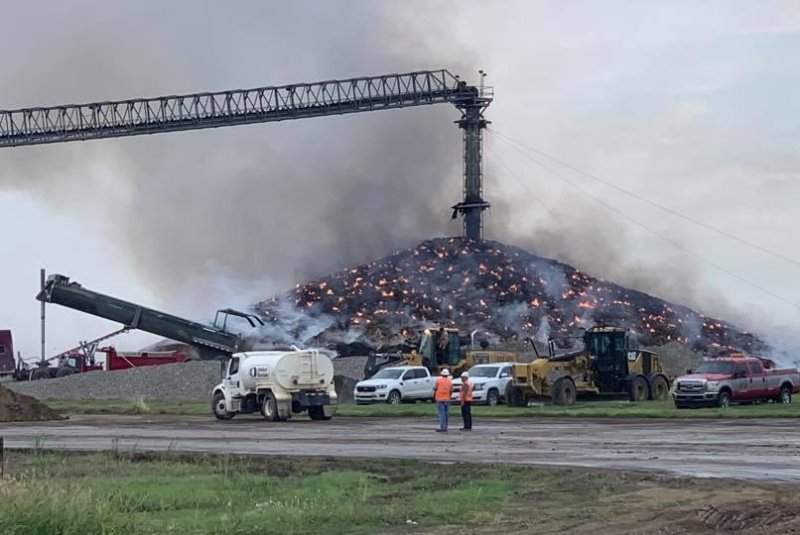1 of 2 | A soybean pile that began rotting after it was soaked in this spring's catastrophic Midwest flooding caught fire in July, and crews have been unable to put it out. Photo courtesy of W.C. Farmer Photography
EVANSVILLE, Ind., Sept. 6 (UPI) -- A mountain of rotting soybeans in Missouri caught fire in July -- and continues to burn.
The huge pile started to rot after being soaked during historic spring flooding that hit northern Missouri, western Iowa and Nebraska, said Patrick Burke, a spokesman for Gavilon, a Nebraska-based company that owns a grain elevator on the property near Rock Port.
"With all that pressure on the decaying beans, it started to heat up," Burke said. "Then, we had a week straight of 100- to 110-degree days. So, essentially, it just combusted."
It is common for grain elevators to store soybeans -- and other grains -- in large outdoor piles, Burke said.
This pile caught fire in mid-July, and crews have been unable to extinguish the blaze for a number of reasons, Burke said.
When the fire started, much of the surrounding area still was underwater, and the roads were impassable, making it impossible for fire crews to reach the site, Burke said.
"Our only access to the facility for a while was by air boat," he said.
Also working against firefighters was the pile itself.
"It's a ground pile, and what happens with ground piles is a crust forms over the top," Burke said. "That crust is basically waterproof. We had one day where it rained a ton -- we basically had 6 inches of rain in 24 hours. It didn't even slow the fire down."
Moreover, because the pile essentially is burning from the inside out, any attempt to extinguish the fire risks exposing more oxygen to the inferno. That could create a much bigger blaze, firefighters said.
The fire is in a remote area, and it's not in danger of spreading to homes or other buildings. So, the company and nearby fire departments decided the safest course of action was to let the beans burn, Burke said.
That presents its own challenges.
On Aug. 8, the fire spread from the outdoor pile into the grain bins. Fire crews from the West Atchison Fire Department, Rock Port Fire Department and five other area departments responded, according to the Atchison County Mail. While the fire crews sprayed water over the bin, salvage crews cut holes in it to remove the unburnt grain, which brought the fire in the bin under control.
Meanwhile, the outdoor pile continues to burn. The company doesn't know how long it will take for the fire to burn out. "It's a large pile," Burke said. "There's a lot of fuel for the fire to burn through."
Gavilon will not say how many bushels of grain the pile contains, but neighbors report the affected area is about the size of a football field, about 35 feet high, glowing bright orange.
"It is really something to see -- and sad to see," said Blake Hurst, president of the Missouri Farm Bureau, who lives a few miles from the Gavilon facility.
This spring's flooding ruined a massive amount of stored soybeans across the Midwest and prevented farmers from planting millions of acres. Yet, the United States still has nearly twice as many soybeans stored across the region as the previous record year, said Patrick Westhoff, the director of the Food and Agricultural Policy Research Institute at the University of Missouri.
More than 1 billion bushels of beans will be in storage this fall, according to U.S. Department of Agriculture estimates.
"That is the largest amount by far we've ever had," Westhoff said. "The previous record was in 2006, and that was 574 million bushels. That is a huge, huge carryover."
The bulging supply is a result of the trade war with China, Westhoff said. China was America's leading soy importer, buying about one-third of all the beans grown in the United States. That market essentially evaporated last summer when China placed high retaliatory tariffs on American soy, forcing Chinese companies to buy from other countries.
Suddenly, millions of bushels of soybeans that had been planted across the Midwest had nowhere to go in the following fall, except to grain bins for storage. The huge oversupply sent prices plummeting.
Although this spring's flooding has ruined stored soy -- and other grains -- across the Midwest, experts suspect the losses won't make much of a dent in the overabundant supply.
"It's not like the floods ruined hundreds of millions of bushels," Westhoff said. "So, it's not a large amount in the scheme of things."















